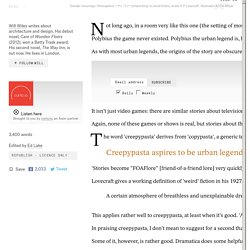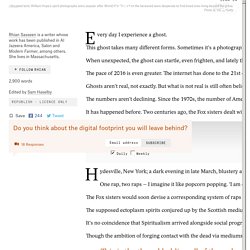

‘Creepypasta’ is how the internet learns our fears. Not long ago, in a room very like this one (the setting of most of these stories is both familiar and vague), I was looking for the origin of a video game.

Polybius was a coin-operated arcade shoot-’em-up released in 1981 to a few suburban locations in Portland, Oregon. The player experience was abstract and psychedelic, involving geometric patterns, bright colours and arcane rules. It was also psychoactive, triggering insomnia, hallucinations and amnesia in its players. These side effects might not have been accidental. Hidden menu operations suggested they were designed in. Polybius the game never existed. As with most urban legends, the origins of the story are obscure and tediously contested. Get Aeon straight to your inbox It isn’t just video games: there are similar stories about television shows.
Again, none of these games or shows is real, but stories about them exist in truly bewildering numbers. Lovecraft gives a working definition of ‘weird’ fiction in his 1927 essay: Why is the internet such a creepily haunted place? Every day I experience a ghost.

This ghost takes many different forms. Sometimes it’s a photograph uploaded to Facebook and stumbled upon at 2 or 3am, an old snapshot in which not all those photographed are still alive. At other times, the ghost is an email, a former acquaintance reaching out from beyond the grave of a friendship, attempting to channel our old selves. Occasionally, the ghost is just the buzzing of a fully-charged phone, oddly similar to a whisper. Always, the ghost is no ghost at all but rather a metaphor, a memory, a foothold between this world and one that no longer exists.
When unexpected, the ghost can startle, even frighten, and lately the rate at which they crop up has been quickening. The pace of 2016 is even greater. Ghosts aren’t real, not exactly. The numbers aren’t declining. It has happened before. Get Aeon straight to your inbox Hydesville, New York; a dark evening in late March, blustery and cold. One rap, two raps – I imagine it like popcorn popping.
Creepypasta, or Internet Scares, if You’re Bored at Work. Photo THERE is a video gaining steam on YouTube called “The Scariest Picture on the Internet (REAL).”

Aside from a short introduction, the bulk consists of a single, still image of a painting set to ominous music. The “scary” part is the back story. According to the introduction, the painting — a simple depiction of a young girl with myopic blue eyes — was made by a teenage Japanese girl who scanned it to her computer, uploaded it to the Internet, then immediately killed herself. “They say it is hard for a person to stare into the girl’s eyes for longer than five minutes,” accompanying text reads. Is it true? The video is part of a growing phenomenon making its way around message boards and e-mail chains called “creepypasta” — bite-sized bits of scariness that have joined the unending list of things-to-do-when-you’re-bored-at-work.
Most creepypasta manufacture their own authenticity. “The stories are always told by someone you could never actually verify,” Mr. Has Creepypasta Reinvented Classic Folklore? Czarna wołga na miarę internetu. Creepypasty. Czarna wołga nie jeździ już po polskich ulicach porywając dzieci, z których spuszczana jest krew.

Miejskie legendy, następcy opowieści ludowych, też przechodzą w niepamięć i ustępują miejsca nowoczesnym wersjom historii, które straszą i budzą niepokój, ale nikt nie potrafi potwierdzić ich prawdziwości. Miejskie legendy ewoluują, zmieniają charakter i stają się creepypastami – odbiciem tego, co dziś przeraża. Animowane wideo stworzone przez Walta Disney’a z Myszką Miki, które przechodzi w psychodeliczny krzyk doprowadziło do samobójstwa pracowników Disney’a, dlatego nigdy nie zostało opublikowane. Automat z lat 80. z grą Polybius, która została zamówiona przez amerykański rząd, by testować użycie gry jako broni. Polybius stanął gdzieś w Portland i doprowadzał graczy do szaleństwa, w 2006 roku pojawił się nawet w Simpsonach.